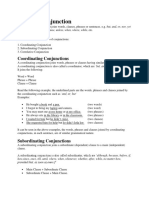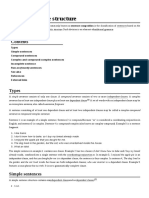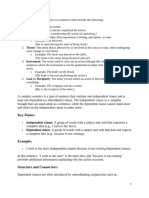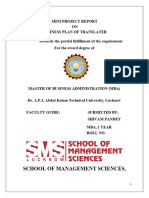0 ratings0% found this document useful (0 votes)
24 viewsShivam Pandey ASSIGNMENT 3
Shivam Pandey ASSIGNMENT 3
Uploaded by
Madhaw ShuklaCopyright:
© All Rights Reserved
Available Formats
Download as PDF, TXT or read online from Scribd
Shivam Pandey ASSIGNMENT 3
Shivam Pandey ASSIGNMENT 3
Uploaded by
Madhaw Shukla0 ratings0% found this document useful (0 votes)
24 views14 pagesCopyright
© © All Rights Reserved
Available Formats
PDF, TXT or read online from Scribd
Share this document
Did you find this document useful?
Is this content inappropriate?
Copyright:
© All Rights Reserved
Available Formats
Download as PDF, TXT or read online from Scribd
Download as pdf or txt
0 ratings0% found this document useful (0 votes)
24 views14 pagesShivam Pandey ASSIGNMENT 3
Shivam Pandey ASSIGNMENT 3
Uploaded by
Madhaw ShuklaCopyright:
© All Rights Reserved
Available Formats
Download as PDF, TXT or read online from Scribd
Download as pdf or txt
You are on page 1of 14
BACHELOR OF COMPUTER
APPLICATIONS (BCA 1ST YEAR)
(2nd semester)
Advance professional communication
Roll no: 191950040010
Submitted by: Shivam pandey
Submitted to: Mr. Shoyeb Ansari
Answer in short.
1. Define phrase and clause with
help of example.
Ans. Phrase is a related group of words.
The words work together as a "unit," but
they do not have a subject and a verb.
Some of Examples are as follows:
• the boy on the bus (noun phrase)
• will be running (verb phrase)
• Martha and Jan (noun phrase)
A clause is a group of words that does have
both a subject and a verb. Some clauses are
independent, meaning that they express a
complete thought. An independent clause is
the same as a complete sentence. Some
clauses are dependent, meaning that they
cannot stand alone.
Some of Examples are as follows:
• When I get home (dependent clause)
The lights are not on. (independent clause)
Put it on the shelf. (Independent clause)
2. What is complex sentence?
Give some example.
Ans. Complex sentences join an
independent clause with a dependent clause.
These sentences are used to show a
particular kind of relationship—usually a
stronger idea joined to a weaker idea.
A complex sentence is a sentence that
contains one independent and at least one
dependent clause (sometimes called a
subordinate clause). An independent clause
is a phrase that would make sense if it were a
sentence on its own, whereas a dependent
clause will not form a sentence on its own.
When these two types of clauses appear in a
sentence, we create a complex sentence.
Some of examples are as follows:
• I like to eat the candy before I watch a
movie.
• Because my coffee was too cold, I heated it
in the microwave.
• When she was younger, she believed in
fairy tales.
3. How many type of
coordination and name them.
Ans. Coordination: Joining two related
ideas of equal importance.
In English grammar, coordination is the
joining of words, phrases, or clauses of the
same type to give them equal emphasis and
importance. The common conjunctions and,
but, for, or, not, yet and so used to join the
elements of a coordinate construction.
Coordination joins two independent clauses
that contain related ideas of equal
importance.
There are two types of coordination that are
additionally utilized, providing special rules for
when the verbs of both clauses are the same:
gapped coordination or joint coordination.
Oftentimes, these are used without thought,
but in order to identify them, there are a few
unique differences between the two.
4. Define verb phrase and
phrasal verb.
Ans. A verb phrase is simply more than
one word which represents a verb, for
example:
‘He looked carefully at the painting to find the
artist’s signature’ – in the sentence ‘looked
carefully at’ is the verb phrase.
Verb phrase refers to the verb itself plus its
objects or complements; phrasal verb refers
to a type of verb consisting of a verb plus a
particle, normally with an idiomatic meaning.
Phrasal verbs, on the other hand, are a
specific type of verb phrase which use a verb
and one or two adverbs to change the
meaning of the main verb significantly.
A verb phrase refers to a verb that has more
than one word whereas a phrasal verb refers
to a verb followed by a preposition or an
adverb.
Phrases like has been, is going, can go,
should have been, etc. are some examples of
Verb phrases whereas turn down, pull over,
look over, etc. are examples of phrasal verbs.
5. Definition and Meaning of
focus verb.
Ans. To give attention, effort, etc. to one
particular subject, situation, or person rather
than another. To adapt or be adjusted so that
things can be seen clearly. To aim light onto a
particular point using a lens. If you focus on a
particular topic or if your attention is focused
on it, you concentrate on it and think about it,
discuss it, or deal with it, rather than dealing
with other topics. The focus of something is
the main topic or main thing that it is
concerned with. Your focus on something is
the special attention that you pay it.
Answer in long.
6. How many type of sentences and what is
the importance of complex sentence?
Ans. There are three types of sentences
which are as follows:
The Simple Sentence
Simple sentences contain a single independent
clause. A simple sentence has only the most
elemental building blocks of a sentence: a subject
and a verb used in a complete thought, also called
an independent clause.
Here's an example, 'Sage howled'. That's as
simple as it gets. It has a subject; it has a verb. It
forms a complete thought.
Here are some other examples of simple
sentences:
• Kristina drank her morning coffee. (Kristina =
subject, drank = verb)
• Kristina showered and dressed. (Kristina =
subject, showered and dressed = compound
verbs)
Simple sentences are usually short. You may use
compound subjects and verbs to add length, but
for the most part, using too many simple
sentences makes your writing choppy.
The Compound Sentence
Compound sentences have two or more
independent clauses and no dependent clauses.
In other words, to make a compound sentence you
join up at least two simple sentences.
If we have the sentences, 'Marsha ran from the
clown' and 'Sage froze in place,' we can make
them a single compound sentence by writing,
'Marsha ran from the clown, but Sage froze in
place.' If you add another independent clause to
that sentence, you still have a compound
sentence. Compound sentences marry two
independent clauses together with a conjunction.
Here's an example, ‘Kristina drank her morning
coffee, and then she showered and dressed’.
Notice the first part of the sentence and the last
part can stand alone as independent sentences.
The key is to not use too many compound
sentences together.
The Complex Sentence
A complex sentence uses an independent clause
combined with one or more dependent clauses. A
dependent clause is similar to an independent
clause, but it can’t stand on its own as a complete
sentence. Complex sentences use conjunctions to
tie them together, too.
A complex sentence is a sentence that contains
one independent and at least one dependent
clause (sometimes called a subordinate clause).
An independent clause is a phrase that would
make sense if it were a sentence on its own,
whereas a dependent clause will not form a
sentence on its own. When these two types of
clauses appear in a sentence, we create a
complex sentence.
Here are some examples of complex sentences:
• Because she woke up late when her alarm
malfunctioned, Kristina missed her morning
train.
• As Kristina watched the train pull out of the
station, she realized she would be late for
work yet again.
Complex sentences join an independent clause
with a dependent clause. These sentences are
used to show a particular kind of relationship—
usually a stronger idea joined to a weaker idea.
7. Difference between phrase and
clause explain.
Ans. Phrase is a related group of words. The
words work together as a "unit," but they do
not have a subject and a verb.
Some of Examples are as follows:
• the boy on the bus (noun phrase)
• will be running (verb phrase)
• in the kitchen (prepositional phrase)
• very quickly (adverb phrase)
• Martha and Jan (noun phrase)
A clause is a group of words that does have
both a subject and a verb. Some clauses are
independent, meaning that they express a
complete thought. An independent clause is
the same as a complete sentence. Some
clauses are dependent, meaning that they
cannot stand alone. They do have a subject
and a verb, but they do not express a
complete thought.
Some of Examples are as follows:
• When I get home (dependent clause)
• The lights are not on. (independent clause)
• When you wake up (dependent clause)
• Put it on the shelf. (independent clause)
• Since it fell on the floor (dependent clause)
8. Define coordination and also
explain its type.
Ans. Coordination: Joining two related
ideas of equal importance.
In English grammar, coordination is the
joining of words, phrases, or clauses of the
same type to give them equal emphasis and
importance. The common conjunctions and,
but, for, or, not, yet and so used to join the
elements of a coordinate construction.
Coordination joins two independent clauses
that contain related ideas of equal
importance.
There are two types of coordination that are
additionally utilized, providing special rules for
when the verbs of both clauses are the same:
gapped coordination or joint coordination.
Oftentimes, these are used without thought,
but in order to identify them, there are a few
unique differences between the two.
In gapping, the verb is omitted from the
second clause, leaving a gap in the middle of
the clause.
On the other hand, joint coordination is used
when a noun phrases cannot be separated
into separate clauses because the words
function as a unit.
9. Difference between verb phrase
and phrasal verb.
Ans. A verb phrase is simply more than
one word which represents a verb, for
example:
‘He looked carefully at the painting to find the
artist’s signature’ – in the sentence ‘looked
carefully at’ is the verb phrase.
Phrasal verbs, on the other hand, are a
specific type of verb phrase which use a verb
and one or two adverbs to change the
meaning of the main verb significantly.
Verb phrase refers to the verb itself plus its
objects or complements; phrasal verb refers
To a type of verb consisting of a verb plus a
particle, normally with an idiomatic meaning.
A verb phrase refers to a verb that has more
than one word whereas a phrasal verb refers
to a verb followed by a preposition or an
adverb. This is the key difference between
verb phrase and phrasal verb. Phrases like
has been, is going, can go, should have been,
etc. are some examples of verb phrases
whereas turn down, pull over, look over, etc.
are examples of phrasal verbs.
10. Write a short story on use of
clause and phrase.
Ans. Clauses and phrases are standard
components of sentence writing. When the
two are combined with other elements of
speech, or other sentences parts, clauses
and phrases can help to establish a complex
structure enabling your verbiage to establish
or convey meaning.
Introductory clauses are considered to be
dependent clauses that offer additional
Information or ‘set the tone’ for the main
clause or part of the sentence- the
independent clause. For example: If you want
to be good at something, you need to practice
as often as possible.
Introductory clauses always begin with
adverbs such as although, after, because, as,
since, if, etc.
Introductory phrases, on the other hand, are
used to set the tone for the action of the
sentence.
If you find that there is a subject and also a
verb with a predicate, it is clause. If a noun is
present, but not a verb or adverb is present,
but not a noun and there is no predicate, it is
a phrase. Phrases and clauses are necessary
parts of speech.
You might also like
- Winer Grammar of New Testamant Greek, Moulton Translation 3rd Ed. With Additions and Index, 1882Document884 pagesWiner Grammar of New Testamant Greek, Moulton Translation 3rd Ed. With Additions and Index, 1882David Bailey100% (3)
- Grammar ReviewDocument8 pagesGrammar ReviewHarlz Berry DemegilloNo ratings yet
- Rhetorical Vocabulary - The Language of CompositionDocument4 pagesRhetorical Vocabulary - The Language of CompositionMarcus JenningsNo ratings yet
- Sentence, Clauses and PhrasesDocument6 pagesSentence, Clauses and PhrasesCarolina Urgilés BustamanteNo ratings yet
- Independent Learning 1Document6 pagesIndependent Learning 1novitaNo ratings yet
- Independent and Dependent ClausesDocument6 pagesIndependent and Dependent ClausesJune SorianoNo ratings yet
- Week 4 Types of SentenceDocument7 pagesWeek 4 Types of SentenceAya MeftiNo ratings yet
- ClauseDocument4 pagesClauseumarNo ratings yet
- Teknik Elektro - Materi 4 - ClausesDocument10 pagesTeknik Elektro - Materi 4 - Clausesbaayu21No ratings yet
- ClausesDocument8 pagesClausessombriokathleenjayNo ratings yet
- What Are AdjectivesDocument13 pagesWhat Are AdjectivesvenreiJoseph69420No ratings yet
- Simple Compound Complex and Compound Complex SentencesDocument7 pagesSimple Compound Complex and Compound Complex SentencesRanti HarviNo ratings yet
- Types of ConjunctionDocument3 pagesTypes of ConjunctionRamil Depalma NebrilNo ratings yet
- Types of ClausesDocument8 pagesTypes of ClausesrelkaderyNo ratings yet
- 5 Tips To Make Constructing English Sentences EasyDocument11 pages5 Tips To Make Constructing English Sentences EasyGlen Mark Macario100% (1)
- Clause AnalysisDocument3 pagesClause Analysisvanilla_42kpNo ratings yet
- Sentence ClauseDocument4 pagesSentence ClauseDilip JaniNo ratings yet
- Phrase, Clause and Types of SentencesDocument8 pagesPhrase, Clause and Types of SentencesJorge Alberto Solórzano NavasNo ratings yet
- Sentence TypeDocument29 pagesSentence Typemumand 4kidsNo ratings yet
- Clauses in English Grammar With Examples PDFDocument6 pagesClauses in English Grammar With Examples PDFhemisphereph2981No ratings yet
- Phrase & Clause: Learning Grammar RulesDocument11 pagesPhrase & Clause: Learning Grammar RulesPtrjhun Acosta GonzalesNo ratings yet
- Complex Sentence ExamplesDocument6 pagesComplex Sentence ExamplesSwadesh BiswasNo ratings yet
- Name:jose Juan Feliz Fernandez: Subject Verb ClauseDocument10 pagesName:jose Juan Feliz Fernandez: Subject Verb ClauseAlbert TejedaNo ratings yet
- Clauses in English Grammar With Examples PDFDocument6 pagesClauses in English Grammar With Examples PDFsandi ath100% (1)
- Meeting 4 Strategic On Multiple Clause NOUN CLAUSEDocument14 pagesMeeting 4 Strategic On Multiple Clause NOUN CLAUSENabilla ChristantiNo ratings yet
- Group 4 AssignmentDocument9 pagesGroup 4 AssignmentRefi AzizaNo ratings yet
- RANGKUMAN MATA KULIAH BAHASA INGGRIS WorDocument13 pagesRANGKUMAN MATA KULIAH BAHASA INGGRIS Workadek supastriNo ratings yet
- What Is An Independent Clause?Document5 pagesWhat Is An Independent Clause?Ericka MarNo ratings yet
- Adjective Clause and Adjective PhraseDocument5 pagesAdjective Clause and Adjective PhraseGhina Almira100% (2)
- Complex Sentence and ClausesDocument11 pagesComplex Sentence and Clauseskhusha yarshahNo ratings yet
- EnglishDocument19 pagesEnglishAliNo ratings yet
- Syntax 1Document10 pagesSyntax 1Sri HartatiNo ratings yet
- Complex SentencesDocument6 pagesComplex SentencesRaman ChahalNo ratings yet
- Topic: Grammatical Issues: What Are Parts of Speech?Document122 pagesTopic: Grammatical Issues: What Are Parts of Speech?AK AKASHNo ratings yet
- Types of SentencesDocument21 pagesTypes of SentencesVimalan KiruthiyanNo ratings yet
- SENTENCE STRUCTURE RulesDocument4 pagesSENTENCE STRUCTURE RulesSalman KhalidNo ratings yet
- General EnglishDocument17 pagesGeneral EnglishalokpandeygenxNo ratings yet
- Kinds of SentenceDocument18 pagesKinds of SentenceNURUL HIDAYAHNo ratings yet
- Common Sentence ErrorsDocument4 pagesCommon Sentence ErrorsrishigivingawayNo ratings yet
- Writing Paragraph - Topic 4Document6 pagesWriting Paragraph - Topic 4elogi.glowNo ratings yet
- ESL Sentence StructureDocument4 pagesESL Sentence StructureAkshay RawatNo ratings yet
- An Easy Guide To Conjunctions (With Conjunction Examples) - 7ESLDocument20 pagesAn Easy Guide To Conjunctions (With Conjunction Examples) - 7ESLYasiruNo ratings yet
- Clauses and Types of ClausesDocument44 pagesClauses and Types of ClausesMuhammad Nouman Yasin100% (1)
- Study Guide For Simple Compound Complex SentencesDocument5 pagesStudy Guide For Simple Compound Complex Sentencesk60.2112450026No ratings yet
- Elp Group1 Lesson 4 7Document17 pagesElp Group1 Lesson 4 7Aries T. SantosNo ratings yet
- Simple, Compound, Compound-ComplexDocument5 pagesSimple, Compound, Compound-Complexaritami rizkyNo ratings yet
- Personal ReviewerDocument41 pagesPersonal ReviewerBea Patricia CutorNo ratings yet
- Sentence Unity and Run OnsDocument4 pagesSentence Unity and Run OnsBryan Rance MacasuNo ratings yet
- 7 Patterns of Sentence StructureDocument20 pages7 Patterns of Sentence StructureCikgu Ambuyun Jr.100% (1)
- 2465.conjunction RulesDocument7 pages2465.conjunction RulesJeevana RauNo ratings yet
- The ClauseDocument13 pagesThe ClauseSonsaku HakufuNo ratings yet
- THE EIGHT PARTS OF SPEECH and Run-Ons and FragmentDocument10 pagesTHE EIGHT PARTS OF SPEECH and Run-Ons and FragmentrenanNo ratings yet
- MAP LA 고학년Document8 pagesMAP LA 고학년Da Min KimNo ratings yet
- AbbiePotterHenry ClausesandhowtoconnectthemDocument5 pagesAbbiePotterHenry ClausesandhowtoconnectthemdejufaniNo ratings yet
- Classification of SentencesDocument5 pagesClassification of SentencesBiancaNo ratings yet
- KLP 6 (Sentence & Type of Sentence)Document5 pagesKLP 6 (Sentence & Type of Sentence)ayu purnamaNo ratings yet
- Clauses & SentencesDocument9 pagesClauses & SentencesAydi EDITORNo ratings yet
- Clauses in EnglishDocument4 pagesClauses in EnglishMinahil KhanNo ratings yet
- Comprehensive English Grammar Guide: From Basics to Competitive ExcellenceFrom EverandComprehensive English Grammar Guide: From Basics to Competitive ExcellenceNo ratings yet
- SHIVAM Pandey Computer 4Document13 pagesSHIVAM Pandey Computer 4Madhaw ShuklaNo ratings yet
- Shivam Pandey ACCOUNT 3Document11 pagesShivam Pandey ACCOUNT 3Madhaw ShuklaNo ratings yet
- Shivam Pandey Accounts Assignment No. 2Document8 pagesShivam Pandey Accounts Assignment No. 2Madhaw ShuklaNo ratings yet
- Final MP Sem2Document54 pagesFinal MP Sem2Madhaw ShuklaNo ratings yet
- Robotics: Where AI Meets Real WorldDocument36 pagesRobotics: Where AI Meets Real WorldMadhaw ShuklaNo ratings yet
- Mini Project Report 1 MbaDocument44 pagesMini Project Report 1 MbaMadhaw ShuklaNo ratings yet
- Unit4 - NegativesDocument28 pagesUnit4 - Negativesjuan carlosNo ratings yet
- Ejercicios BachillerDocument19 pagesEjercicios BachillerEva Maria Parraga Martinez100% (1)
- Pronoun Review-AngelaDocument7 pagesPronoun Review-Angelaxzha809No ratings yet
- Evolve 5 5th. Period General ReviewDocument18 pagesEvolve 5 5th. Period General ReviewXimena LunaNo ratings yet
- English Grammar RULESDocument5 pagesEnglish Grammar RULESSaroj KumarNo ratings yet
- Practical Work AdjectivesDocument9 pagesPractical Work AdjectivesJuana JoNo ratings yet
- Introduction To The Cambridge English Course StatedDocument19 pagesIntroduction To The Cambridge English Course StatedmicaprimNo ratings yet
- Noun Noun Phrase Stress - OkayDocument20 pagesNoun Noun Phrase Stress - OkayEaswaradas SivadasNo ratings yet
- Navigate Pre-Intermediate Wordlist Unit 5Document2 pagesNavigate Pre-Intermediate Wordlist Unit 5DescargadorxdNo ratings yet
- Computational Linguistics: Lecture 1: IntroductionDocument25 pagesComputational Linguistics: Lecture 1: IntroductionDalia AhmedNo ratings yet
- Teaching Plan For Basic Conversation ClassDocument3 pagesTeaching Plan For Basic Conversation Classyogi rahmadNo ratings yet
- Articles in English GrammarDocument11 pagesArticles in English GrammarAbrar HussainNo ratings yet
- Errata First Quarter 2020 Region 4a CalabarzonDocument60 pagesErrata First Quarter 2020 Region 4a CalabarzonRenanteNo ratings yet
- Past ContinuousDocument5 pagesPast ContinuousAndrea Magdolna MoldovanNo ratings yet
- Action Verb: Functions of Nouns 1.subjectDocument2 pagesAction Verb: Functions of Nouns 1.subjectazu azuNo ratings yet
- Sentence DiagrammingDocument29 pagesSentence DiagrammingJoshua JethrohNo ratings yet
- Second Mid-Term Evidence PortfolioDocument13 pagesSecond Mid-Term Evidence PortfolioDIANE EDITH LUNA TOPETENo ratings yet
- True or False?: Esl / Efl ResourcesDocument1 pageTrue or False?: Esl / Efl ResourcesAléxia AndradeNo ratings yet
- Grammar PracticeDocument2 pagesGrammar PracticemileslegionisNo ratings yet
- Simple Present - Practice 1Document2 pagesSimple Present - Practice 1juan gomezNo ratings yet
- The Indicative MoodDocument7 pagesThe Indicative Moodspalikus72No ratings yet
- 3rd Exam English 7Document3 pages3rd Exam English 7rhenz deztroidNo ratings yet
- Adjective Clause Worksheet EslDocument6 pagesAdjective Clause Worksheet EslHugh YipNo ratings yet
- Syntax: Basic Verb PhraseDocument19 pagesSyntax: Basic Verb PhraseMaulana MualimNo ratings yet
- Combining Clauses Into Clause Complexes: A Multi Faceted ViewDocument78 pagesCombining Clauses Into Clause Complexes: A Multi Faceted ViewThiyazenNo ratings yet
- Rubric For Speaking AssessmentDocument1 pageRubric For Speaking Assessmentapi-381227832100% (1)
- Tugas B.inggrisDocument15 pagesTugas B.inggrisAisyah YuniarNo ratings yet
- Direct and Indirect SpeechDocument8 pagesDirect and Indirect Speechlsr630196No ratings yet































































































